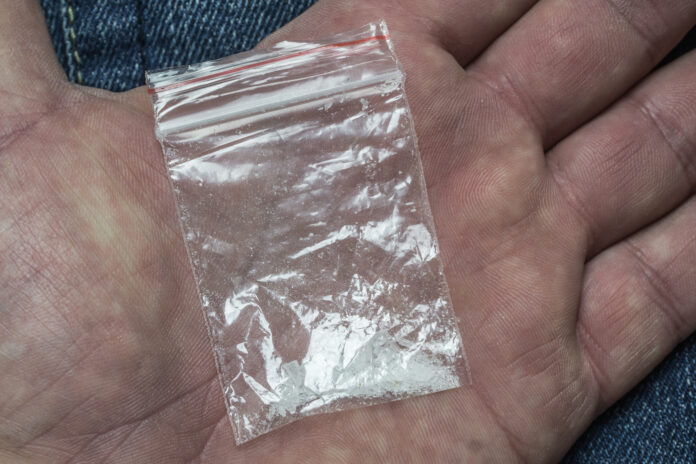Due to being in recovery, some sources in this story requested PGN only use their first names.
“I like to tell people, ‘Don’t ever try meth. You’ll love it,’” said Evan, who’s been in recovery from a meth addiction since early 2021. “The problem is that it’s so good, it’s a level of dopamine that’s released in your brain that’s unlike anything else.”
Methamphetamine use continues to be an issue that impacts queer men. According to the NYC Vital Signs report “Understanding Crystal Methamphetamine Use Among Men Who Have Sex with Men,” in 2021 and 2022, an estimated 5.3% of gay men in the U.S. used meth within the past year.
In Evan’s experience, using meth “brings a lot of people together who are lonely and don’t know what to do with it,” he said. “[Meth] lives in bath houses and clubs and hotel rooms. It creates these spaces that I think a lot of queer men are craving, which is connection with other queer men or queer people in general. The reality is that we think we’re building a connection, but we’re all high so there is no connection.”
When Evan used meth for the first time, six months passed before he used the drug again. Then, there was a three-month gap before his next use, followed by one month and then a week before he began doing meth every day.
“I was kind of just letting it happen and not really paying attention,” Evan said. “Once you start using [meth] every day, it gets pretty dark pretty fast, especially because this was early 2020. The pandemic hit and all of a sudden everyone’s inside, not talking to anyone else.”
Evan was eventually able to get into treatment for his meth addiction. The second time around, he stayed in recovery and has been sober since 2021. “I maintain that it’s the hardest thing I’ve ever done, and one of the scariest things I’ve ever done,” Evan said. Now, in recovery, he has found community by making authentic connections, he said.
Side effects of short-term meth use typically include insomnia, anxiety, paranoia, hallucinations, a decrease in appetite, raised heart rate and blood pressure, and other negative effects. Long-term users are at risk of suffering irreversible damage to the brain, liver or kidneys, severe tooth decay and an increased chance of stroke.
“I think people need to understand just how dangerous [meth] is,” said Kevin Hyer, who is also in recovery and now serves as founder and CEO of the Hyer Calling Foundation, which provides job coaching and other services for people in recovery from addiction. “[Meth] is very addictive and very powerful. It can do tremendous damage to your life. A lot of people with meth end up homeless. It screws your career, your health, your mental health, too.”
Jacob, who’s now in recovery, initially tried meth when his older boyfriend offered it to him. He was experiencing homelessness at the time and had dabbled with other substances. Another factor in why meth use is so common among men who have sex with men, both Jacob and Hyer said, is that it increases sex drive.
“You can have sex for hours and hours,” Jacob said. “It makes a lot of people make risky decisions.”
Among MSM meth users, exchanging sex for drugs is common, Jacob said. Dating apps that are popular among MSM are other avenues where queer men can access meth.
“There are apps that you can go on and you can look up ‘party and play’ houses,” Jacob said. “They call them GMOs — gay meth orgies. A lot of people fall into [using meth] by accident. Say you’re homeless, you might have some mental health issues or some addiction issues; most people [on meth] are awake for four or five days at a time. That’s four or five days of free housing, minimum.”
Now in recovery, Jacob lives in a sober house, has an office job, and as someone who went through the 12-step program, sponsors other people in recovery.
Another element in why meth is so dangerous is that more and more of the supply is laced with fentanyl, a deadly opioid that has been turning up in other street drugs like heroin. There are varying opinions in terms of abstinence versus harm reduction when addressing a meth addiction.
As for the benefits of using meth in an overdose prevention site (OPS) “it would be better, but it’s still dangerous,” Hyer said. “It’s another tool to help reduce harm. I think it’d be useful, but not everyone is going to go to an overdose prevention site.”
Evan is a harm reductionist at heart, he said.
“I think that having harm reduction on the forefront is saving people’s lives,” Evan added. “The second you’ve put regulations on how people can and can’t live, it drives everything underground. That’s when we get dirty drugs; that’s when we lose access to cleaner using supplies. That’s when HIV and hep C rates spike.”
In September 2023, Philadelphia City Council members introduced a bill that would ban overdose prevention sites in most of Philadelphia, with the exception of the 3rd District in West and Southwest Philly. At the time, Mayor Jim Kenney vetoed the bill. However, incoming mayor Cherelle Parker has stated in a press release that she does not support an overdose prevention site in Philly.
“Drug consumption sites are not the answer to this crisis,” Parker said.
José de Marco, a local activist and harm reduction advocate, said that meth users can do some simple things to stay as healthy as possible until they’re ready to go into treatment.
“We found that in harm reduction, people who are coerced into treatment never stay,” de Marco said. “Or when they stay long enough, they get themselves a little bit healthy and they go back out and use again.”
They would tell people using meth who aren’t ready to go into treatment, “how not to lose your teeth, to make room to eat, [to use] condoms if you’re not on PrEP. Telling folks –– if you’re going to do Tina [meth], there’s PrEP.”
The role of an OPS and meth addiction is “a multifaceted issue,” Jacob said. “Nowadays, my last relapse, I could not find meth without fentanyl in it. In that sense, [an OPS] would be super beneficial.”
However, unlike heroin, for example, there is no medication-assisted treatment for meth, Jacob said.
In terms of helping someone struggling with a meth addiction, Jacob would tell them to find a nearby 12-step meeting. He mentioned William Way LGBT Community Center as a place to turn to for recovery meetings.
“I’ve seen people stumble into the William Way center just because they knew it would be safe there, wind up in a meeting and then have the potential to get into treatment,” Jacob said. “The best thing to do is tell someone else there’s hope. You’re worth loving. And if you don’t love yourself, somebody else in recovery will love you until you get there.”

